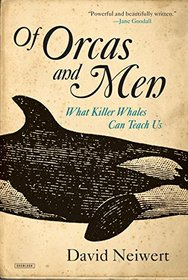I remember reading about Namu when I was a child. Namu was the first documented killer whale (orca) captured and displayed for the public. During his short lifespan, Namu helped change public opinion of orcas from that of the most vicious and intelligent killer in the sea to cuddly intelligent beast that only kills when needed to live. However, neither view truly captures the complexity of this amazing animal, nor was Namus tale the beginning of the story of interactions between mankind and orca, nor was it to be the ending
In his book Of Orcas and Men: What Killer Whales Can Teach Us, David Neiwert covers the historical and cultural gamut of encounters between humans and orcas (although heavily weighted towards those in and from Washington and British Columbia). These go back to look at the historic record of the native peoples of those areas, through to the local residents and tourists today as well as the companies who own aquatic-based theme parks displaying orcas and the employees who work at and tourists who visit those attractions. He also looks at individuals humans who research the whales, humans who captured and displayed them, and even individual orcas in captivity and in the wild.
The author succeeds in writing a non-fiction narrative that does not have the dry feel of a textbook, drawing the reader in with narratives and anecdotes while also referencing studies and findings based both on wild whales and those in captivity.
Mr. Neiwert strives to write a balanced report, although he makes no effort to disguise his preference that orcas should not be held in captivity, whether captured in the wild or captive-bred. As such, he occasionally falls into the trap of quoting statistics and studies that back his personal opinion as gospel, while pooh-poohing those that disagree with his view. However, unlike some authors, Mr. Neiwert DOES at least make note of these conflicting accounts, rather than ignoring them altogether.
While not perfect, this is a highly recommended read.
RATING: 4.5 stars, rounded down to 4 stars for those sites that cannot handle fractions of a star.
DISCLOSURE: I received this book free of charge from the publisher without obligation, although a fair and unbiased review would be appreciated.
In his book Of Orcas and Men: What Killer Whales Can Teach Us, David Neiwert covers the historical and cultural gamut of encounters between humans and orcas (although heavily weighted towards those in and from Washington and British Columbia). These go back to look at the historic record of the native peoples of those areas, through to the local residents and tourists today as well as the companies who own aquatic-based theme parks displaying orcas and the employees who work at and tourists who visit those attractions. He also looks at individuals humans who research the whales, humans who captured and displayed them, and even individual orcas in captivity and in the wild.
The author succeeds in writing a non-fiction narrative that does not have the dry feel of a textbook, drawing the reader in with narratives and anecdotes while also referencing studies and findings based both on wild whales and those in captivity.
Mr. Neiwert strives to write a balanced report, although he makes no effort to disguise his preference that orcas should not be held in captivity, whether captured in the wild or captive-bred. As such, he occasionally falls into the trap of quoting statistics and studies that back his personal opinion as gospel, while pooh-poohing those that disagree with his view. However, unlike some authors, Mr. Neiwert DOES at least make note of these conflicting accounts, rather than ignoring them altogether.
While not perfect, this is a highly recommended read.
RATING: 4.5 stars, rounded down to 4 stars for those sites that cannot handle fractions of a star.
DISCLOSURE: I received this book free of charge from the publisher without obligation, although a fair and unbiased review would be appreciated.




